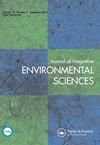利用国家综合评估模型调查不同缓解情景下的生物多样性趋势
IF 3.5
4区 环境科学与生态学
Q3 ENVIRONMENTAL SCIENCES
Journal of Integrative Environmental Sciences
Pub Date : 2023-08-04
DOI:10.1080/1943815x.2023.2239323
引用次数: 0
摘要
本文章由计算机程序翻译,如有差异,请以英文原文为准。
Investigating biodiversity trends in different mitigation scenarios with a national integrated assessment model
ABSTRACT The inclusion of Sustainable Development Goals (SDGs) in climate mitigation pathways is critical and can be reached by assessing their consequences through the deployment of appropriate indicators to that end. Integrated Assessment Models (IAMs) are important tools for understanding possible impacts caused by adopting new policies. We investigate terrestrial biodiversity trends (life on land: SDG 15) for three different climate mitigation scenarios for Brazil: (1) A scenario compatible with a world that maintains its current policies with current deforestation rates in the Amazon and the Cerrado biomes; (2) A scenario in which Brazil fulfils its Nationally Determined Contribution (NDC); and (3) A scenario compatible with a world that limits warming to 1.5°C. We use the Brazilian Land-Use and Energy System model (BLUES), a national IAM, to show the implications of the transitions involved in the above-mentioned scenarios for the country up to 2050. We conduct a post-processing analysis using consolidated biodiversity indicators to emphasize how different IAM greenhouse gas (GHG) emissions mitigation solutions present distinct positive and negative potential impacts on biodiversity in Brazil. However, our analysis does not consider the impacts associated with climate change, but only the risks imposed by mitigation policies. Our results indicate that biodiversity loss decreases in the scenarios from (1) to (3), implying that stronger climate change mitigation actions could result in smaller biodiversity losses. We conclude that Brazil has the opportunity to align its biodiversity and climate goals through nature-based solutions (NBS), such as forest conservation, restoration, pasture recovery, and the use of crop-pasture and agroforestry systems.
求助全文
通过发布文献求助,成功后即可免费获取论文全文。
去求助
来源期刊

Journal of Integrative Environmental Sciences
ENVIRONMENTAL SCIENCES-
CiteScore
3.90
自引率
0.00%
发文量
13
审稿时长
>12 weeks
期刊介绍:
Journal of Integrative Environmental Sciences (JIES) provides a stimulating, informative and critical forum for intellectual debate on significant environmental issues. It brings together perspectives from a wide range of disciplines and methodologies in both the social and natural sciences in an effort to develop integrative knowledge about the processes responsible for environmental change. The Journal is especially concerned with the relationships between science, society and policy and one of its key aims is to advance understanding of the theory and practice of sustainable development.
 求助内容:
求助内容: 应助结果提醒方式:
应助结果提醒方式:


